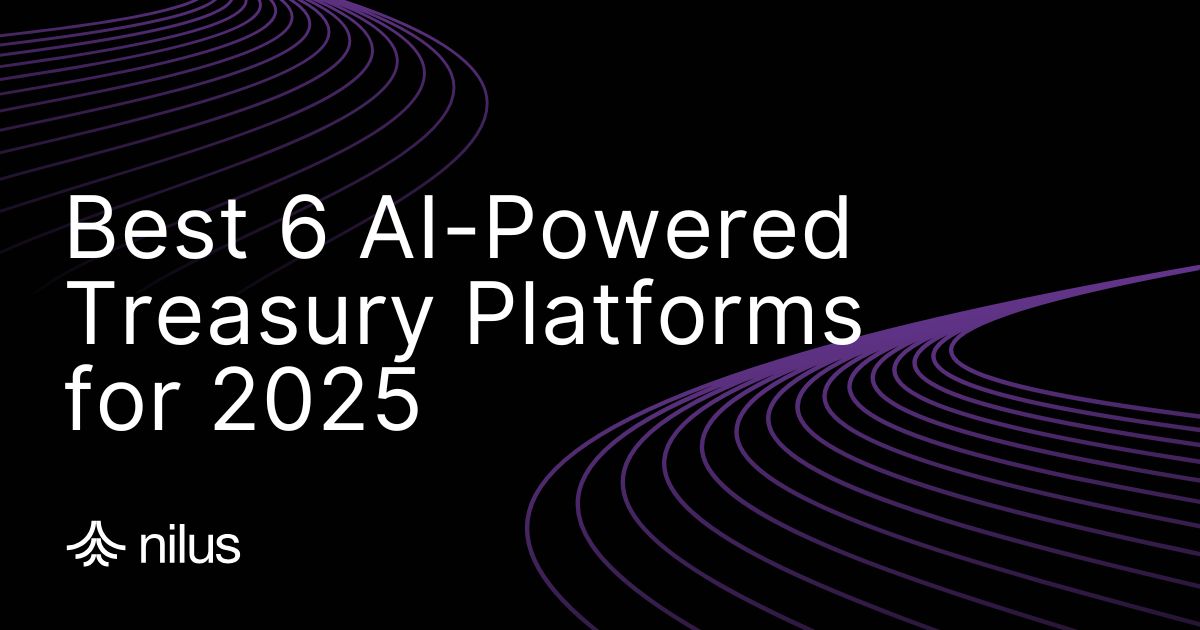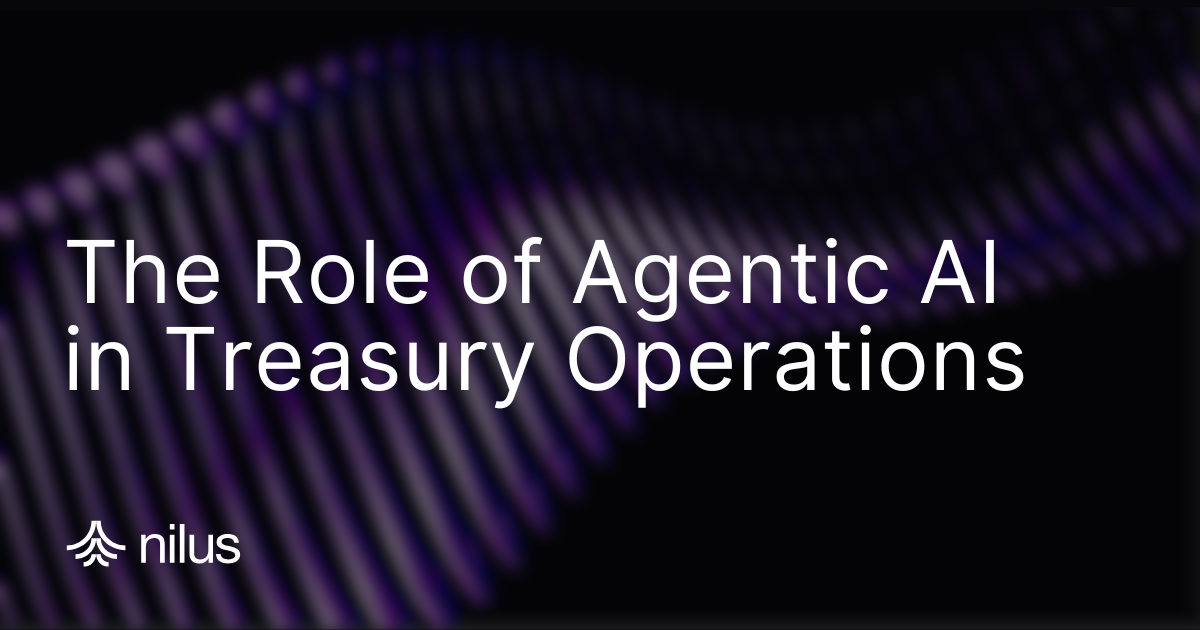10 Best Treasury Management Software in 2025

If you’re still juggling spreadsheets and logging into three bank portals just to check your daily cash position, you’re not alone. But in 2025, it’s getting harder to justify. Treasury has gone from reactive number-crunching to a strategic command center. And that shift demands better tools.
Today’s treasury management software (TMS) isn’t just about automation. It’s about real-time visibility, faster decision-making, and AI that flags issues before they become problems. Whether you're managing multi-entity complexity, trying to improve forecast accuracy, or just tired of reconciling payments by hand, the right TMS changes everything.
In this post, we’ll walk through the 10 best treasury management software solutions available in 2025. You’ll see what each one is best for, what features actually matter, and how to choose a system that fits the way your team works, not the other way around.
Let’s dive in.
Why Treasury Software Is a Must-Have in 2025
Let’s be real: treasury isn’t just about “managing cash” anymore. It’s about navigating volatility, optimizing working capital, and making fast, data-informed decisions when the stakes are high. And none of that is possible if you're stuck chasing down yesterday’s numbers in Excel.
The modern treasury team needs more than visibility; they need foresight. That’s why treasury management software has become essential. These systems centralize your bank and ERP data, automate painful workflows, and use AI to flag issues before they hit your P&L.
Here’s what’s pushing more teams to upgrade their tech stack in 2025:
- Manual reconciliations are a time sink. Pulling transactions from different banks, categorizing payments, and fixing formula errors isn't just inefficient; it’s risky.
- Cash flow forecasts are too slow to matter. By the time your weekly forecast is ready, it’s outdated. You need tools that update in real time.
- Decision-making is delayed. Whether it’s a last-minute investment decision or a sudden funding need, waiting hours for reports is no longer acceptable.
- Audit and compliance pressures are up. Regulators and boards want transparency, fast. A TMS with built-in controls and audit trails makes that easy.
Bottom line: if your treasury function is still stitched together with spreadsheets and siloed tools, it’s not just an inconvenience; it’s a competitive disadvantage.
Key Features to Look for in Treasury Management Software
Not all treasury systems are created equal. Some offer beautiful dashboards but little substance. Others drown you in complexity with features your team will never use.
What matters most is this: does the system actually make your day easier? Can it replace three tools, cut hours off your month-end process, or surface insights before they become issues?
Here are the must-have features that make a real difference:
Real-Time Bank and ERP Integrations
Manual uploads should be extinct. The best systems pull live data from your bank accounts, ERPs, and payment providers, so you see today’s cash position, not last week’s.
AI-Powered Forecasting
Treasury teams no longer need to build forecasts from scratch. AI can learn your inflow/outflow patterns, spot anomalies, and suggest adjustments as new data rolls in.
Multi-Entity, Multi-Currency Capabilities
If you operate globally, you need tools that handle complex structures. That means cash by legal entity, FX exposure tracking, intercompany sweeps, and consolidated group views, on demand.
Visual Dashboards (That Go Deep)
Pretty charts are nice, but you also need to drill from group-level liquidity to transaction-level detail, fast. The right TMS lets you zoom in without exporting to Excel.
Scenario Modeling
“What if collections slow by 10% next quarter?” “What if we delay a CapEx project?” Software should let you test assumptions quickly, not rebuild a model from scratch.
Built-In Controls and Audit Trails
You shouldn’t need a separate tool for compliance. A good TMS tracks approvals, changes, and data flows automatically, so you’re always audit-ready.
The Best Treasury Management Software List
We’ve evaluated dozens of platforms and narrowed it down to the 10 best treasury management systems for 2025. Whether you're running a multi-entity finance operation or just trying to get out of spreadsheet chaos, there’s something here for you.
Each system is included with its ideal use case, standout strengths, and when to consider it.
1. Nilus
Best for: Mid-to-enterprise companies looking for AI-powered forecasting and real-time cash insights
Strengths:
- Native AI models trained on treasury data
- 20,000+ bank connections
- Cash flow forecasting, reconciliation, and scenario modeling in one place
- Real-time visibility across all entities, currencies, and accounts
Consider if: You want to eliminate manual work, improve forecast accuracy, and unlock insights that drive strategic liquidity decisions. Nilus is built for modern treasury teams that need speed, clarity, and automation.
2. SAP Treasury and Risk Management
Best for: Large enterprises deeply invested in SAP ERP
Strengths:
- Integrated with SAP’s financial suite
- Strong in financial risk management (FX, IR, commodities)
- Customizable workflows for complex operations
Consider if: You’re already on SAP and need treasury features to live within your existing stack.
3. Tesorio
Best for: Mid-market companies focused on AR-driven cash forecasting
Strengths:
- Strong AR automation and cash collections visibility
- Easy-to-use cash forecasting interface
- Collaboration between finance and sales teams
Consider if: Collections are your cash engine, and you want forecasting tied closely to receivables.
4. HighRadius
Best for: Enterprise treasury teams focused on order-to-cash and working capital optimization
Strengths:
- AI-driven receivables forecasting
- Deductions and dispute management
- Integrated working capital solutions
Consider if: You have complex receivables and need a robust collections platform with treasury forecasting capabilities.
5. Coupa Treasury
Best for: Procurement-heavy orgs with an integrated source-to-pay strategy
Strengths:
- Strong cash management features
- Native to Coupa’s spend platform
- FX and risk modeling capabilities
Consider if: You already use Coupa or want treasury tied closely to spend visibility.
6. Kyriba
Best for: Enterprises needing deep cash and risk management functionality
Strengths:
- Comprehensive TMS with modules for liquidity, FX, payments, and more
- Good for multi-entity, global organizations
- Scenario modeling and hedge accounting
Consider if: You’re looking for a full-suite solution with a mature ecosystem.
7. Oracle Treasury
Best for: Enterprises already running Oracle Financials
Strengths:
- Deep ERP integration
- Core cash and debt management tools
- Global bank connectivity (via SWIFT)
Consider if: You’re in the Oracle ecosystem and want treasury functionality without adding another vendor.
8. Treasury Intelligence Solutions (TIS)
Best for: Companies looking for multibank connectivity and payment workflow control
Strengths:
- Strong bank integration layer
- Secure, centralized payment processes
- Good for AP automation and audit compliance
Consider if: Payment control and bank rationalization are top priorities.
9. Mercury
Best for: Startups and tech companies that want treasury-lite capabilities
Strengths:
- Simple cash dashboard
- FDIC sweep accounts for cash management
- Quick setup for growing companies
Consider if: You’re not ready for a full TMS but need better visibility than your bank portal provides.
10. Arc
Best for: VC-backed startups looking to extend runway and improve financial clarity
Strengths:
- Integrated with revenue-based financing tools
- Clear visibility into burn, runway, and inflows
- Lightweight forecasting capabilities
Consider if: You're an early-stage and need cash flow insights alongside financing options.
How to Choose the Right Treasury Management Software
The “best” treasury system isn’t the one with the most features; it’s the one that fits how you operate.
Here’s a step-by-step guide to help you choose the right TMS without getting overwhelmed by vendor checklists or sales demos.
Step 1: Map Your Workflows First
Before you shop, map out your current treasury process. Where do your team’s hours go? What’s still manual? Which tools don’t talk to each other? The goal is to pinpoint friction.
Step 2: Define Your Integration Needs
List your core systems: ERP, accounting software, banks, PSPs. Your TMS should plug into these cleanly. If you're manually exporting CSVs every week, you’ll want automation as a priority.
Step 3: Get Clear on Forecasting Requirements
Do you need daily cash visibility or 13-week rolling forecasts? Want to model scenarios? If forecasting is a core pain point (it usually is), lean toward systems with built-in AI and scenario tools.
Step 4: Think in Modules
Some platforms (like GTreasury or Kyriba) let you choose specific modules: cash, payments, risk, etc. Others (like Nilus or Tesorio) are focused on cash flow and forecasting. Choose what fits your current priorities, not everything at once.
Step 5: Align With Team Capacity
If your team is small or doesn’t have technical resources, prioritize tools that are plug-and-play with strong support. Ask: “Can we self-serve, or will we need to lean on consultants for setup and changes?”
Step 6: Prioritize Outcomes, Not Features
Don’t get caught in a feature checklist war. Ask each vendor:
- What work will this eliminate for my team?
- How does it improve forecast accuracy?
- How fast can I see my total cash position every morning?
Step 7: Test Real Scenarios
Request a live demo or sandbox. Run a real forecast. Try uploading historic data. Simulate a payment delay or cash shortfall. If it’s clunky in the demo, it’ll be clunky in production.
Need help evaluating tools?
Check out this post from treasury leaders on how they picked the right system.
The Right Treasury System Pays for Itself
Treasury software isn’t just a tech upgrade, it’s a mindset shift. It’s how modern finance teams move from reactive number-wrangling to proactive decision-making.
Whether you’re trying to improve cash visibility, model risk, or stop wasting hours in spreadsheets, the right system can fundamentally change how your team operates. The best part? Many platforms now make that shift faster and more accessible than ever.
Ready to Modernize Your Treasury Stack?
Nilus helps leading finance teams unlock:
- Real-time cash positions across banks and entities
- AI-powered forecasting and variance tracking
- Automation that replaces manual reconciliation and reporting
Book a free consultation to see Nilus in action, and get your team out of spreadsheet chaos.
FAQ
What does a treasury management software do?
Treasury management software helps finance teams manage cash, track liquidity, forecast future inflows/outflows, and reduce risk. It automates bank data aggregation, reconciliations, and reporting, freeing up time and improving accuracy across treasury operations.
How to implement a treasury management system?
Start by cleaning and consolidating your financial data. Choose a system that integrates with your ERP and banks, then work with the vendor on onboarding and training. Modern cloud-based platforms like Nilus can be up and running in weeks, not months.
How to evaluate treasury management systems?
Evaluate based on real-time data capabilities, forecasting tools, ease of use, integration strength, and support. Run a demo using your actual workflows, and focus on systems that remove manual work, not just display dashboards.
How to utilize treasury management software effectively?
Use it as your daily command center. Set alerts, track forecast vs actual, model scenarios, and review KPIs regularly. Involve FP&A and accounting early to ensure it supports cross-functional needs like planning, compliance, and working capital strategy.
Your next treasury move is waiting
Get an ROI assessment, and find out where you’re leaving cash on the table.

Your next treasury move is waiting
Get an ROI assessment, and find out where you’re leaving cash on the table.

More Resources
Your next treasury move is waiting
Get an ROI assessment, and find out
where you’re leaving cash on the table.







